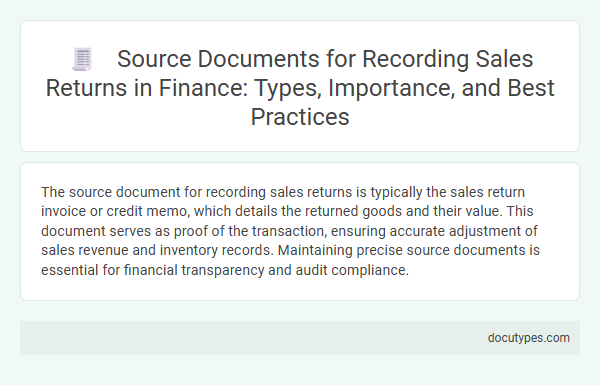The source document for recording sales returns is typically the sales return invoice or credit memo, which details the returned goods and their value. This document serves as proof of the transaction, ensuring accurate adjustment of sales revenue and inventory records. Maintaining precise source documents is essential for financial transparency and audit compliance.
Introduction to Source Documents in Sales Returns
Source documents play a crucial role in accurately recording sales returns. They provide verifiable evidence necessary for maintaining correct financial records.
- Sales Return Slip - This document details the products returned by the customer, including quantities and reasons.
- Credit Memo - Issued to authorize a reduction in the amount payable by the customer due to the return.
- Returned Goods Receipt - Confirms the physical receipt of returned items back into inventory.
Key Types of Source Documents for Sales Returns
Source documents for recording sales returns serve as the original proof of returned goods and are essential for accurate financial records. Key types include sales return slips, credit memos, and return authorization forms, each capturing crucial details such as customer information, product quantities, and reasons for return. These documents ensure proper adjustment of sales revenue and inventory in accounting systems.
The Role of Credit Notes in Recording Sales Returns
The source document for recording sales returns is typically the credit note, which serves as formal evidence of returned goods. Credit notes play a crucial role in accurately updating financial records by documenting the reduction in sales revenue.
- Credit Note Issuance - A credit note is issued by the seller to the buyer, detailing the returned items and the amount to be credited.
- Accounting Impact - The credit note adjusts accounts receivable and sales revenue, reflecting the decrease caused by the sales return.
- Audit Trail - Credit notes provide an essential audit trail, ensuring transparency and verification in the sales return process.
Accurate use of credit notes helps maintain precise financial statements and supports effective inventory management during sales returns.
Importance of Accurate Sales Returns Documentation
The source document for recording sales returns is typically a credit memo issued by the seller. This document serves as official proof that goods were returned and a refund or credit has been authorized.
Accurate sales returns documentation is vital for maintaining precise financial records and inventory management. Your accounting team relies on these documents to reconcile accounts and prevent discrepancies in revenue reporting.
Common Mistakes in Handling Sales Returns Documents
| Aspect | Description |
|---|---|
| Source Document for Recording Sales Returns | The primary source document used to record sales returns is the Sales Return Note (Credit Note). This document authorizes the return of goods from the customer to the company and adjusts the sales records accordingly. It serves as proof for accounting entries and inventory updates. |
| Common Mistakes in Handling Sales Returns Documents |
|
Best Practices for Managing Sales Returns Source Documents
The source document for recording sales returns is typically the credit memo issued by the seller. This document serves as proof of the return transaction and details the returned items, quantities, and reasons for the return.
Best practices for managing sales returns source documents include maintaining accurate and timely records to ensure proper accounting adjustments. Organizing these documents systematically helps streamline the reconciliation process and prevents discrepancies in financial reports involving your sales returns.
Electronic vs. Manual Source Documents in Sales Returns
The source document for recording sales returns is essential for maintaining accurate financial records. Understanding the differences between electronic and manual source documents helps ensure precise tracking of returned goods.
- Electronic Source Documents - Automated entries capture sales return details instantly, reducing human error and speeding up the reconciliation process.
- Manual Source Documents - Physical forms or receipts require manual input, which can delay processing and increase the likelihood of data entry mistakes.
- Data Integrity and Accessibility - Electronic documents promote better data accuracy and easy retrieval, while manual records may face challenges in storage and consistency.
Compliance and Audit Requirements for Sales Returns Documents
What is the source document for recording sales returns? The source document for sales returns is typically the credit memo or sales return authorization form issued by the seller. These documents ensure compliance by providing accurate records that auditors can verify during financial reviews.
Impact of Sales Returns Documentation on Financial Reporting
The source document for recording sales returns is typically the sales return slip or credit memo issued by the seller. Accurate documentation of sales returns ensures precise adjustments to accounts receivable and revenue, maintaining the integrity of financial records. Properly recorded sales returns directly impact financial reporting by providing a clear reflection of net sales and affecting profit calculations and inventory management.
What Is the Source Document for Recording Sales Returns? Infographic

